The Java Sparrow (Lonchura oryzivora) is a charming and iconic bird species native to the Indonesian islands of Java, Bali, and Madura.
Renowned for its striking black and white plumage and friendly nature, the Java Sparrow has captured the fascination of bird enthusiasts worldwide.
With its adaptability to various habitats and cultural significance in its native range, this species holds a special place in people’s hearts across Southeast Asia and beyond.
Let’s delve into the captivating world of the Java Sparrow and explore its unique characteristics, behavior, and conservation status.
Common Characteristics Of Java Sparrow
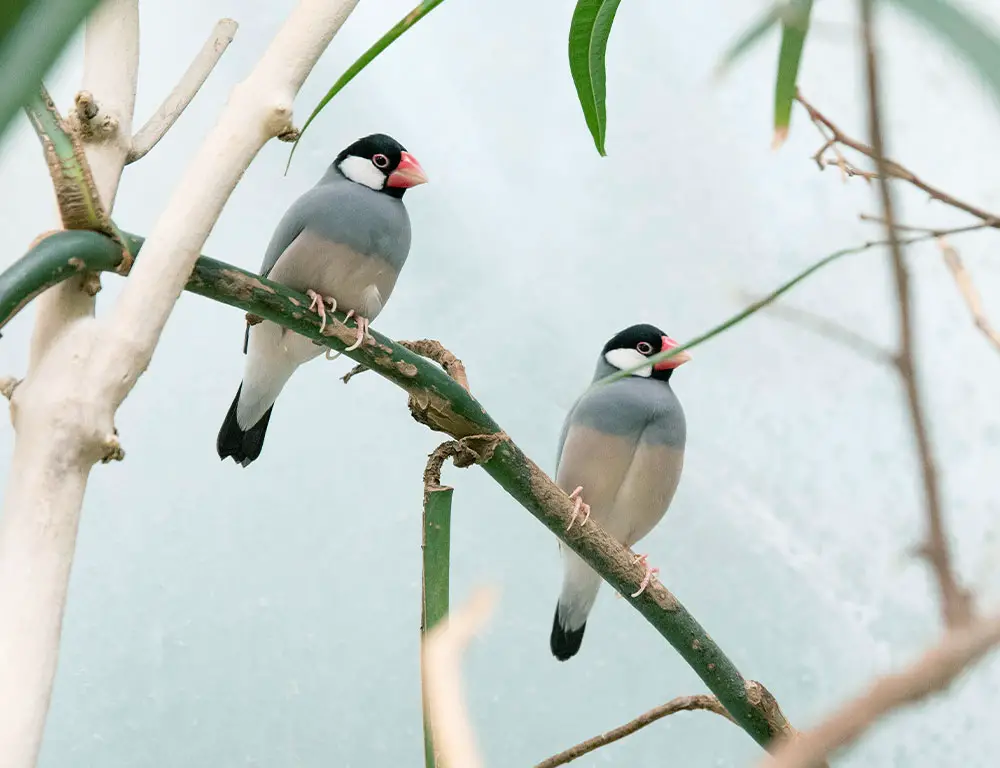
The Java Sparrow is a small and colorful bird that belongs to the family Estrildidae. It is native to Java and Bali in Indonesia but has been introduced to many other parts of the world as a caged bird.
It is also known as the Java Finch, the Java Rice Sparrow, or the Java Rice Bird. Here are some of the common characteristics of this attractive and friendly bird:
Physical Characteristics
The Java Sparrow is a small and colorful bird that belongs to the family Estrildidae. It is native to Java and Bali in Indonesia but has been introduced to many other parts of the world as a caged bird.
It is also known as the Java Finch, the Java Rice Sparrow, or the Java Rice Bird. Here are some of the physical characteristics of this attractive and friendly bird:
Size and shape
The Java Sparrow is about 15 cm long and weighs around 25 g. It has a plump body, a large head, a short tail, a thick bill, and short legs. The bill is conical and robust, adapted for cracking seeds and grains.
Color and pattern
The Java Sparrow has a primarily grey plumage, with a black head, throat, and upper breast. It has a white cheek patch, a pinkish-red eye ring, and a pinkish-red bill.
The rump and tail are white, and the wings are brown with white bars. The legs and feet are pinkish-red. The female is similar to the male but duller and more minor. The juvenile is brownish-grey with a black bill and a dark eye ring.
Sexual dimorphism
The Java Sparrow exhibits sexual dimorphism, which means that the male and female have different appearances. As described above, the male is slightly larger and brighter than the female.
The male also has a longer and thicker bill than the female, which may help attract mates and display dominance.
Moult
The Java Sparrow undergoes a partial moult once a year, usually after the breeding season. During this time, the bird may lose some of its feathers, especially on the head and the wings.
The moult lasts for about a month, and the bird regains its fresh and glossy plumage afterwards.
Voice
The Java Sparrow is a noisy and vocal bird that produces a variety of sounds, such as chirps, whistles, clicks, and trills. The male sings more often and louder than the female, especially during the breeding season and early morning.
The song attracts mates, defends territories, and communicates with other birds. The bird can also produce harsh and alarm calls when threatened or disturbed.
Diet and nutrition
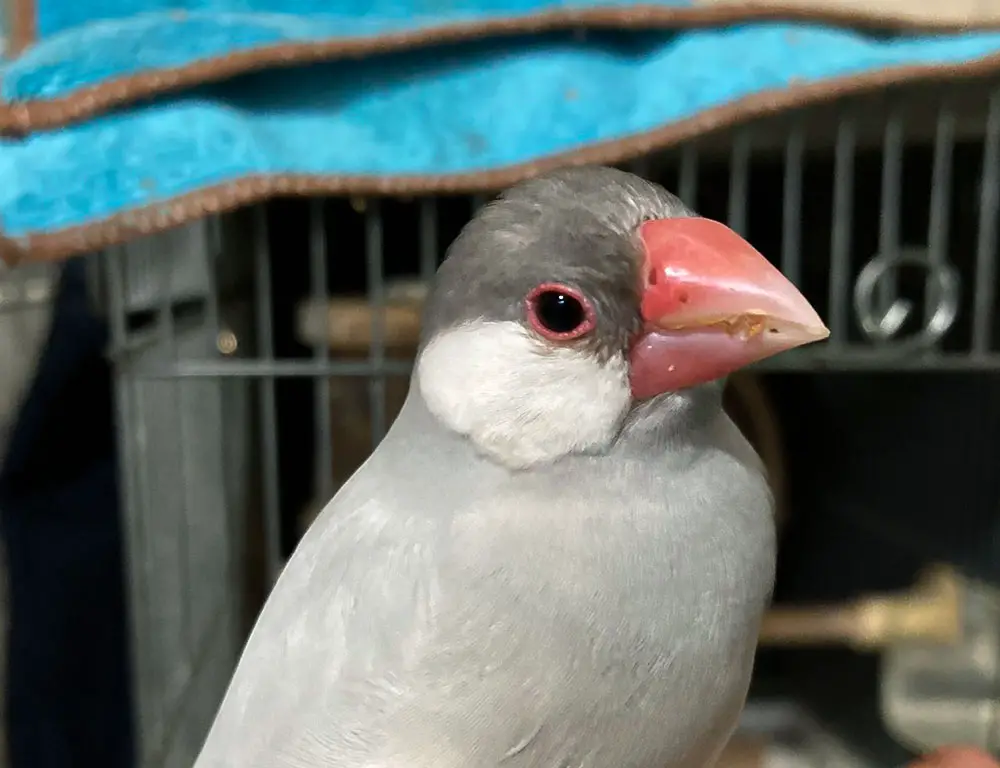
The Java Sparrow is mainly granivorous, feeding on seeds and grains of rice, millet, wheat, barley, and other crops. It also occasionally eats fruits, vegetables, insects, and worms.
The bird forages on the ground or in low vegetation, often in large flocks. It may also visit bird feeders or human settlements to find food. It needs to drink water regularly and may visit ponds, streams, or puddles to quench its thirst.
Reproduction
The Java Sparrow breeds from April to October, depending on the region. The pair forms a monogamous bond and defends a territory. The nest is built by both sexes, usually in a tree hole, an aperture, or a cavity.
The nest is made of grass, straw, feathers, and other materials, lined with finer materials. The female lays 4 to 8 eggs, which are white or pale blue. The incubation period is about 13 to 14 days; both parents feed the chicks.
The fledging period is about 21 to 25 days, and the young may stay with their parents for some time before dispersing.
Distribution and Habitat
The Java Sparrow has a natural range that covers Java and Bali, as well as some nearby islands such as Madura and Lombok. It has also been introduced to other regions, such as Southeast Asia, India, China, Japan, Australia, Africa, and the Americas.
It occupies various habitats, such as grasslands, savannas, farmlands, plantations, and urban areas. It prefers open or semi-open areas with trees and shrubs and avoids dense or arid regions.
Taxonomy
The Java Sparrow belongs to the order Passeriformes, the largest and most diverse group of birds. It is a member of the family Estrildidae, which includes waxbills, munias, and firefinches.
The table below shows the taxonomic classification of the Java Sparrow:
| Taxonomic Level | Classification |
| Kingdom | Animalia |
| Phylum | Chordata |
| Class | Aves |
| Order | Passeriformes |
| Family | Estrildidae |
| Genus | Lonchura |
| Species | Lonchura oryzivora |
This table presents the Java Sparrow’s hierarchical classification within the broader animal kingdom taxonomy, providing insight into its systematic placement among other bird species.
Aviculture
The Java Sparrow is a popular and easy-to-keep cage bird kept as a pet for centuries. It is admired for its beauty, personality, and song. It can be kept in pairs or groups and get along with other finches.
It needs a spacious and secure cage with perches, toys, and a nest box. It also requires a balanced diet of seeds, grains, fruits, vegetables, and supplements. It can live for up to 10 years in captivity and breed throughout the year.
Nesting
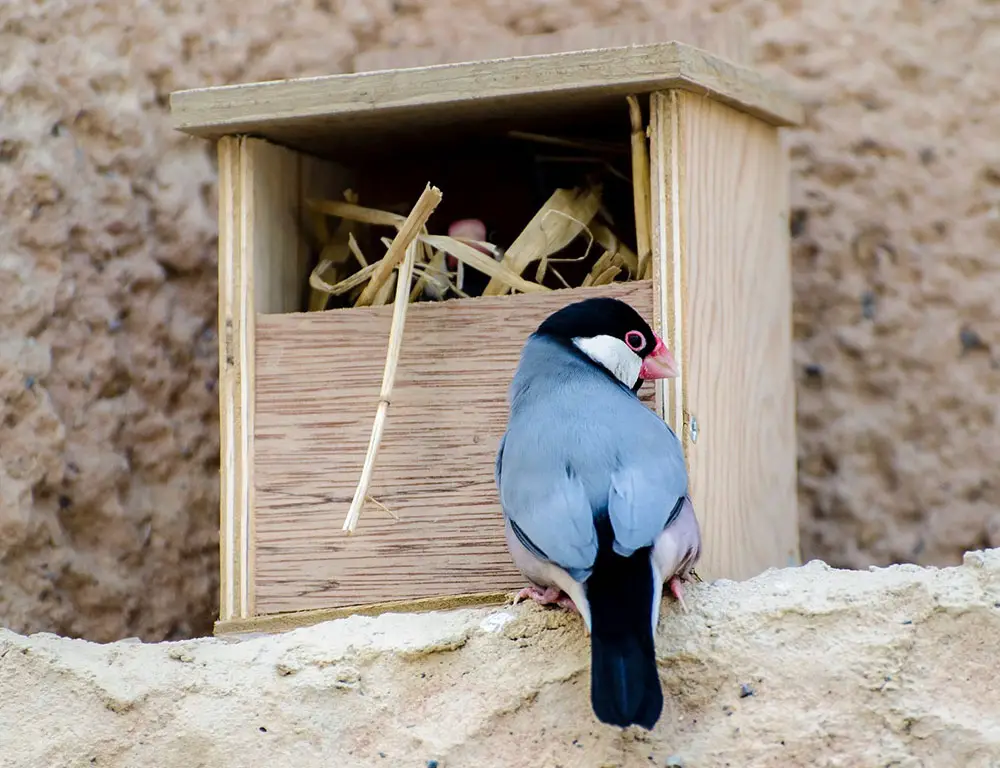
The Java Sparrow breeds from April to October, depending on the region. The pair forms a monogamous bond and defends a territory. The table below shows some of the nesting habits of the Java Sparrow:
| Nesting Habit | Description |
| Location | Typically builds nests in dense vegetation such as shrubs, bushes, or small trees. |
| Nest Structure | Generally cup-shaped, with a shallow depression to hold the eggs and protect the young. |
| Nest Shape | It is positioned within the interior of the vegetation, providing concealment and protection from predators. |
| Nest Placement | Positioned within the interior of the vegetation, providing concealment and protection from predators. |
| Nesting Behavior | Both male and female birds contribute to nest building, with the female primarily responsible for incubating the eggs. |
| Clutch Size | Typically lays 3-6 eggs per clutch, with an incubation period of around 11-14 days. |
This table provides an overview of the nesting habits of the Java Sparrow, highlighting key aspects such as location, structure, placement, behavior, and clutch size during the nesting process.
Food
The Java Sparrow is mainly granivorous, feeding on seeds and grains of rice, millet, wheat, barley, and other crops. It also occasionally eats fruits, vegetables, insects, and worms.
The bird forages on the ground or in low vegetation, often in large flocks. It may also visit bird feeders or human settlements to find food. It needs to drink water regularly and may visit ponds, streams, or puddles to quench its thirst.
Ranging Map
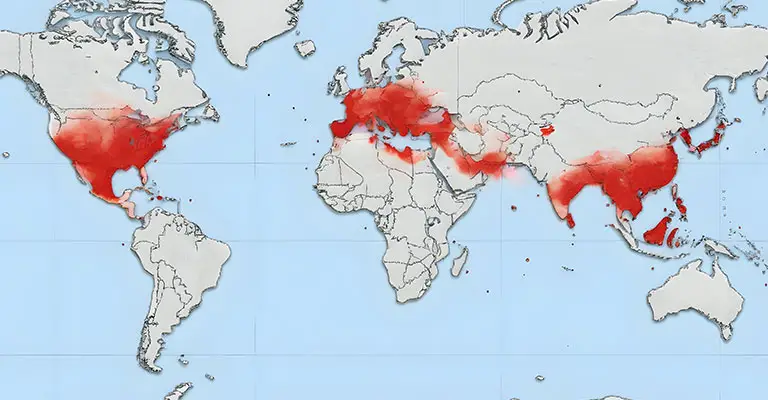
The Oriental Magpie-Robin is widely distributed, with populations found in India, Bangladesh, Sri Lanka, Nepal, Bhutan, Myanmar, Thailand, Cambodia, Vietnam, Malaysia, Singapore, Indonesia, and the Philippines.
In South Asia, the Oriental Magpie-Robin is commonly found in various habitats, including gardens, parks, forests, and urban areas.
It is a familiar sight in cities and towns across India, where it often frequents gardens and open spaces and rural areas with scattered trees and shrubs.
In Southeast Asia, the Oriental Magpie-Robin inhabits a range of ecosystems, from lowland rainforests to montane forests and mangrove swamps.
It can be observed in Thailand, Malaysia, Indonesia, and the Philippines, occupying a similar range of habitats as in South Asia.
Why Is Java Sparrow Endangered?
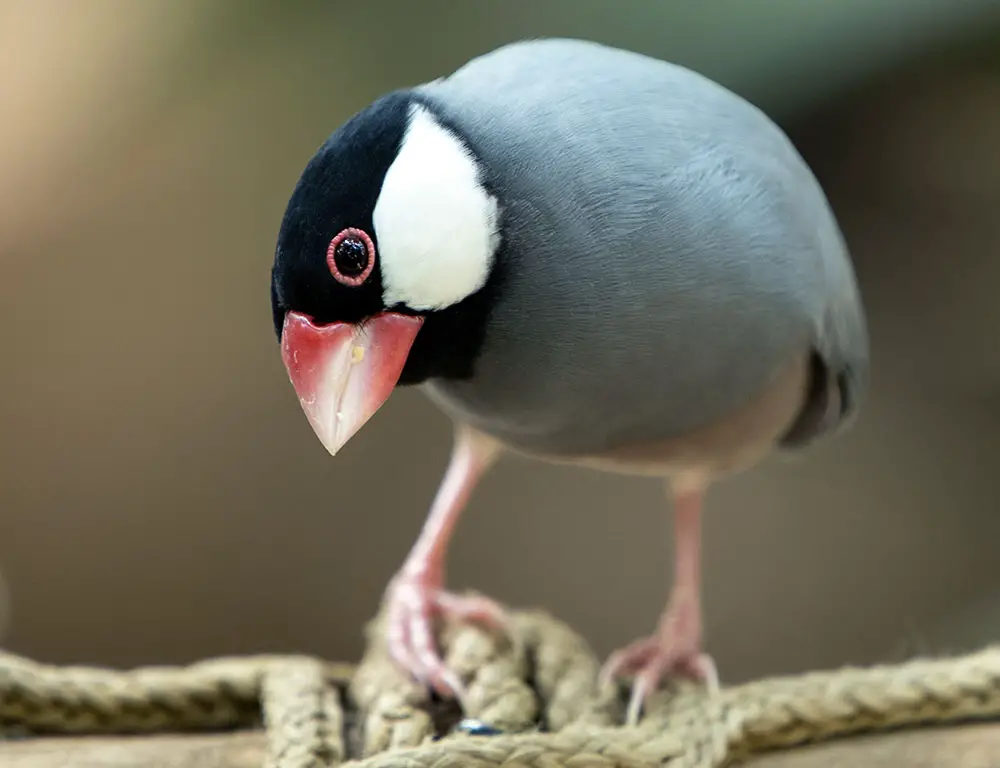
The Java Sparrow (Lonchura oryzivora) faces significant threats to its survival, leading to its endangered status. Several factors contribute to the decline of this charismatic bird species, ranging from habitat loss to illegal trapping and trade.
Understanding these challenges is crucial for devising effective conservation strategies to safeguard the future of the Java Sparrow population.
Habitat Loss
Destruction and degradation of natural habitats due to urbanization, agriculture expansion, and deforestation are major threats to Java Sparrow populations. Loss of suitable nesting sites and foraging areas limit the bird’s ability to find food and reproduce.
Illegal Trapping for the Pet Trade
The Java Sparrow is highly sought after in the illegal wildlife trade due to its attractive plumage and pleasant song. Illegal trapping and trade for the pet market have resulted in significant declines in wild populations, particularly in its native range in Indonesia.
Introduction of Invasive Species
Competition and predation by invasive species, such as rats and feral cats, pose a threat to Java Sparrow populations. These introduced species outcompete native birds for resources and may prey on Java Sparrow eggs and nestlings.
Habitat Fragmentation
Fragmentation of remaining habitats due to human activities isolates Java Sparrow populations, reducing genetic diversity and increasing vulnerability to extinction.
Fragmented habitats also make it difficult for birds to find suitable mates and establish viable breeding populations.
Pesticide Use
The indiscriminate use of pesticides in agricultural areas threatens Java Sparrows by contaminating their food sources and causing direct mortality.
Pesticides may also accumulate in the birds’ bodies, leading to long-term health effects and reproductive issues.
Climate Change
Alterations in temperature and precipitation patterns associated with climate change can impact Java Sparrow habitats, affecting food availability and breeding success.
Increased frequency of extreme weather events, such as storms and droughts, further exacerbates these threats.
Lack of Conservation Awareness
Limited public awareness about the plight of the Java Sparrow and its ecological importance hinders conservation efforts.
Education and outreach programs are needed to raise awareness about the species’ conservation status and promote sustainable practices to mitigate threats.
Addressing these multifaceted challenges requires collaborative efforts involving governments, conservation organizations, local communities, and the general public to protect and conserve the Java Sparrow and its habitat for future generations.
7 Interesting Facts About Java Sparrow
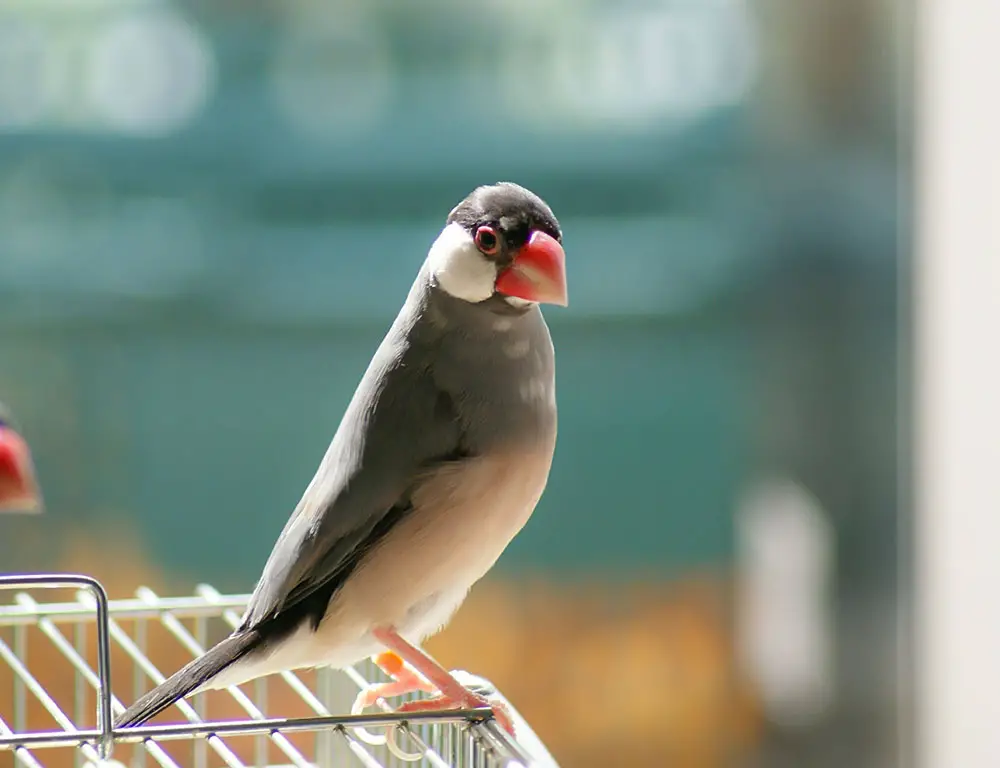
Here are seven interesting facts about the Java Sparrow (Lonchura oryzivora):
Iconic Appearance
Java Sparrows are easily recognizable by their striking black and white plumage, with a bold white cheek patch, black head, and chestnut-colored patches on their flanks.
Social Creatures
These birds are highly social and often found in flocks, especially during the non-breeding season. They communicate through various vocalizations and engage in mutual preening to maintain social bonds.
Adaptable Diet
Java Sparrows have a varied diet, feeding on seeds, grains, insects, and small fruits. They are frequent visitors to agricultural fields and may sometimes be considered pests by farmers.
Cultural Symbolism
In their native range of Indonesia, Java Sparrows are considered symbols of love and good fortune. They are often kept as pets and featured in traditional ceremonies and cultural events.
Skillful Nest Builders
During the breeding season, Java Sparrows construct dome-shaped nests from grasses, twigs, and other plant materials. These nests are typically hidden in dense vegetation for protection.
Global Distribution
Although native to Java, Bali, and Madura islands in Indonesia, Java Sparrows have been introduced to other regions, including Southeast Asia, Hawaii, and parts of Africa, where they have established feral populations.
Conservation Status
While not currently listed as globally threatened, Java Sparrows face various threats in their native range, including habitat loss, illegal trapping for the pet trade, and competition with invasive species. Conservation efforts are underway to protect their remaining populations and habitat.
These fascinating facts shed light on the unique characteristics and significance of the Java Sparrow in both its native and introduced ranges.
Faqs
Where are Java Sparrows found?
Java Sparrows are native to the Indonesian islands of Java, Bali, and Madura. However, they have been introduced to other regions, including Southeast Asia, Hawaii, and parts of Africa, where they have established feral populations.
What do Java Sparrows eat?
Java Sparrows have a varied diet, primarily on seeds, grains, insects, and small fruits. They forage on the ground and in vegetation, often visiting agricultural fields and gardens.
Are Java Sparrows social birds?
Yes, Java Sparrows are highly social and often found in flocks, especially outside the breeding season. They communicate through various vocalizations and engage in mutual preening to maintain social bonds.
Do Java Sparrows breed in captivity?
Yes, Java Sparrows are commonly bred in captivity for the pet trade and aviary enthusiasts. They adapt well to captive environments and may breed readily with proper care and housing.
Are Java Sparrows endangered?
While not currently listed as globally threatened, Java Sparrows face various threats in their native range, including habitat loss, illegal trapping for the pet trade, and competition with invasive species.
Conservation efforts are underway to protect their remaining populations and habitat.
Conclusion
The Java Sparrow is a testament to avian life’s beauty and resilience. While celebrated for its iconic appearance and cultural symbolism, this species faces numerous threats in the wild, including habitat loss and illegal trapping for the pet trade.
As we continue to appreciate and admire the Java Sparrow, let us also advocate for its conservation and strive to protect its remaining populations and habitats.
Through collective efforts, we can ensure a brighter future for this beloved bird species and preserve its legacy for generations.